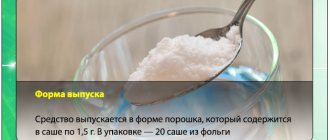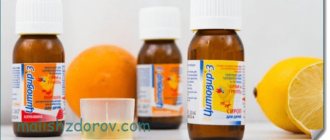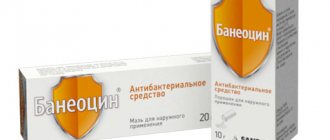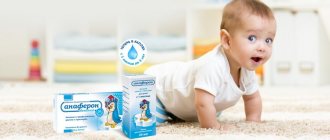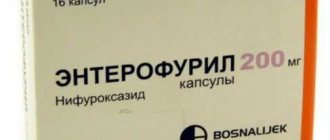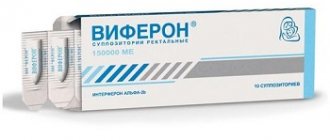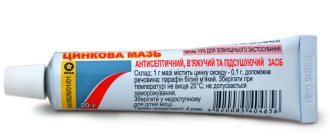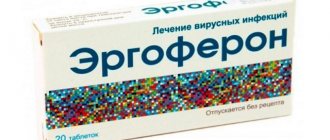Baneocin is an antibiotic intended for local external use, suitable for the treatment of dermatological diseases in children from one year of age and newborns. The medicine is produced in the form of an ointment and in crumbly form by the Austrian company BIOCHEMIE. The powder is available in 10 g bottles and is white with a yellowish tint; the ointment is sold in 20 g tubes.
What does it help with?
Many people are interested in how to use Baneocin and what it helps with.
The medicine has a very wide range of uses:
- The ointment is used for bacterial skin lesions, purulent inflammation of the apocrine sweat glands, periungual fold, hair follicle, abscess, carbuncle, streptoderma, boils and other purulent infections.
- The drug is used to prevent abscesses, rashes, cuts, suppuration of wounds and other skin injuries. For example, the drug in crumbly form is used to treat punctures of the navels, noses, and ears.
- In addition, in this form it can be used for angular cheilitis, burns and for the treatment of chicken rash.
- Otolaryngologists prescribe the drug after sinus surgery, for inflammation of the mucous membrane, sinuses or paranasal cavity and inflammation of the external ear.
- In the surgical field, the product is used to protect sutures from bacterial infection after surgery.
- Gynecologists prescribe medicine after childbirth to care for sutures and cracked nipples during breastfeeding.
general characteristics
The drug, intended for external use only, contains a combination of antibiotics such as neomycin and bacitracin. These two components enhance each other's action.
Manufacturers produce the product in powder form and as an ointment. The powder is white (sometimes has a yellowish tint) placed in a jar with a convenient dispenser, volume 10 g. The auxiliary component in the powder is corn starch.
What is Baneocin powder? The antibacterial components included in the drug are able to fight pathogenic bacteria on the surface and inside the wound. They stop their reproduction and stop the spread of infection. Eliminate the source of inflammation and reduce unpleasant symptoms such as burning, pain, itching.
The drug is not addictive. Continues its effect even if urine, blood or sweat gets on the powder layer.
It is often prescribed to newborns for rapid healing of the umbilical wound when it begins to fester, to eliminate the symptoms of diaper rash. Baby powders for diapers do an excellent job of eliminating redness and diaper rash on the skin.
They create a protective film between the diaper fabric and the skin surface. Baneocin copes with the consequences of diaper rash when a bacterial infection occurs.
The drug can be purchased at any pharmacy. The cost of the product in powder form is approximately 350 rubles.
There are no complete analogues in powder form. But you can replace it with ointments with a similar effect: Levomekol, Tetracycline, Erythromycin. They are also used to heal infected wounds. They have antimicrobial and antibacterial effects.
Instructions for use
Instructions for use are quite simple and do not require special medical training or explanation from a doctor. The drug must be applied locally, exactly to the damaged area of the skin. Can be applied openly or covered with a bandage. Treating infected areas with Baneocin ointment should be done two to three times a day, the powder is applied two to four times a day.
For burns that occupy more than 1/5 of the body surface, Baneocin is used no more than once a day. This restriction prevents the substance from being absorbed into the bloodstream.
When treating the external auditory canal, extensive wounds and cuts that heal with the formation of scars, cotton swabs should be soaked in the ointment and inserted into the infected part of the body or into the wound. Under no circumstances should the medicine come into contact with the eyes.
When carrying out a long course of treatment with Baneocin, even according to the instructions, there is a risk of developing fungal diseases. The product can lead to allergies, in which case it is necessary to stop using it immediately.
For children
The powder is often used as a powder on the baby's umbilical wound from birth. Due to its high efficiency, it copes with the wound in 2-5 days. Doctors recommend it both for treating a regular wound and for combating an inflamed and festering navel stump.
To treat a native navel wound, you need to rinse it with 3% hydrogen peroxide, dry it with a cotton pad and pour the powder inside.
The procedure is carried out twice a day for three to five days until the wound is completely healed. If the navel stump is inflamed, then the product should be used up to five times a day. The entire procedure is carried out in the same way as when treating a standard wound. Healing can take up to a week.
Baneocin powder for newborns is used in the treatment of diaper dermatitis. The substance is used as a powder. The course of treatment reaches a maximum of 10 days.
Baneocin for children is also used in the treatment of various burns, calluses, cuts, scratches, bites, skinned elbows and knees. It is successfully used instead of traditional alcohol, brilliant green and iodine, which kids don’t like so much. Moreover, Baneocin is actively used for acne and boils. The product copes well with children's prickly heat.
Treatment of the umbilical wound. How to do everything right?
- Wounds of babies
- How to care for an umbilical wound?
The umbilical cord remnant in newborns is the so-called umbilical wound.
It is difficult to predict when it is used as an “entry gate” by infectious agents. This can happen at any unfavorable moment.1 Therefore, timely and correct treatment of the umbilical wound is so important.
Three infectious agents. Why doesn't my baby's belly button heal?
The causative agents of the infection are varied, but most often the umbilical wound is used as a target for attack by staphylococci,3 as well as E. coli.1 Treatment for the diseases they cause can take time and effort.
Staphylococcus aureus (Staphylococcus aureus)
plays a major role in human infectious pathology.
Staphylococcal infections pose the greatest danger to maternity hospitals, where newborns first encounter staphylococcus.3 Escherichia coli (Escherichia coli)
can cause purulent-inflammatory processes in organs and tissues with a sharp decrease in the body’s resistance.3
If the umbilical wound is not treated correctly, infectious agents use it to penetrate the tissues adjacent to the navel.
4 As a result, omphalitis may develop
– inflammation of the bottom of the umbilical wound, skin and subcutaneous tissue, as well as umbilical vessels.5 The disease can lead to complications.
4 Healing of the umbilical wound with omphalitis will not happen on its own; it must be preceded by treatment prescribed by the doctor.
Weeping navel with discharge of pus.5
Swelling and redness around the navel.5
*The images shown are for illustrative purposes only, are for artistic purposes only and may differ from actual images.
Timely treatment of the umbilical wound is extremely important. Indeed, in case of complications of omphalitis
In newborns, peritonitis, liver abscesses4, and sepsis5 may occur.
Peritonitis (peritonitis; Greek, peritonaion peritoneum + -itis) is inflammation of the peritoneum, accompanied by severe general symptoms of a disease of the body with disruption of the functions of vital organs and systems.3
*The images shown are for illustrative purposes only, are for artistic purposes only and may differ from actual images.
Abscess (abscessus; Greek abscess; abscess) is a limited accumulation of pus in various tissues and organs.3
*The images shown are for illustrative purposes only, are for artistic purposes only and may differ from actual images.
Sepsis (Greek: sepsis putrefaction) is a general nonspecific infectious disease characterized by constant or periodic penetration of various microorganisms and their toxins from the local source of infection into the bloodstream.3
*The images shown are for illustrative purposes only, are for artistic purposes only and may differ from actual images.
Prevention of bacterial complications of the umbilical wound lies in proper care of it.5
If the navel does not heal, how to properly treat the wound for a newborn? What are the algorithm and technique? In Soviet practice, treatment of the umbilical wound was carried out using various antiseptic agents.
It was recommended to use a 3% solution of hydrogen peroxide followed by drying with 70% alcohol, a 1-2% alcohol solution of brilliant green or a 3-5% solution of potassium permanganate.6 Now the advisability of applying many of the listed medications to ensure healing of the umbilical wound is questioned .
1 What is the reason?
Studies have shown that treating the umbilical wound of a newborn with some of these agents can contribute to the development of omphalitis1. And there are a number of reasons for this
Alcohol-containing products
can accelerate the drying of the membranes and form “pockets” when the detachment of the umbilical cord membranes has already begun.1
Potassium permanganate
can lead to an acid burn with the formation of a burn scab and the accumulation of pus under it.2
A number of experts express the opinion that treatment of the umbilical wound does not require the application of antiseptic solutions.1 The algorithm and technique are proposed differently. If the belly button does not heal for more than two weeks and begins to get wet, there is no need to hesitate.1 How long it takes for the umbilical wound to heal largely depends on your actions. Do not prescribe treatment yourself - consult a doctor.
To prevent umbilical infection in newborns, a combined antibacterial drug for external use, Baneocin® powder, can be used.
It contains two antibiotics: neomycin and bacitracin7.
The umbilical wound, thanks to their combination in the composition of the drug, heals faster than when using a combination of hydrogen peroxide and brilliant green or a 5% solution of potassium permanganate.2 Baneocin® powder is easy to use because
it can be applied without touching the wound7.
*The images shown are for illustrative purposes only, are for artistic purposes only and may differ from actual images.
- Absorbs a large volume of wound discharge, helps dry the wound2
- The powder, together with wound discharge, forms an antibacterial crust over the wound2
- Does not injure the skin, creates an evaporating surface2
Source: https://www.Baneocin.ru/childrenswounds3/-3/kak-ukhazhivat-za-pupochnoy-ranoy/
Dosage
The maximum dose of medication per day should not exceed 1 gram of the active substance; during treatment, you cannot use more than 200 grams of the drug per day. When using maximum doses (200 grams), the course of treatment is one day. When a doctor prescribes a second course of treatment, the dosage is halved. Violation of the prescribed portions leads to toxic damage to the ear and kidneys, so treatment should be carried out under the strict supervision of a doctor.
Contraindications
The drug is not recommended for use in case of very large skin lesions, as this provokes toxic poisoning and negative effects on the kidneys. The substance is not prescribed in the following cases:
- For eye diseases;
- In case of disturbances in the functioning of the vestibular or cochlear apparatus;
- For kidney problems;
- With background use of aminoglycoside antibiotics internally;
- If the eardrum is damaged;
- In case of special sensitivity to any component of the substance.
Use the medicine very carefully in case of dysfunction of the muscular and nervous systems. Therapy in this case should be carried out under the strict supervision of the attending physician.
- Recommended reading: Diaper rash in a baby
Features of the drug
The product is a powder that is located inside a plastic jar. For ease of use, the manufacturer also offers an ointment that is placed inside an aluminum tube. Baneocin powder contains two active antibiotics (bacitricin and neomycin). Corn starch, lanolin and paraffin are used as additional fastening components. Thanks to these components, Baneocin powder and ointment kill microorganisms harmful to the baby’s skin. The effect is achieved just a few minutes after application.
With the help of Baneocin you can get rid of a number of living creatures harmful to the body:
- pathogenic gram-positive bacteria;
- fungi;
- gram-negative bacteria.
The drug can be used to treat the skin of a newborn. At the same time, it was possible to minimize the likelihood of developing immunity in almost all strains of bacteria. The ointment retains its positive properties for several years. Even in contact with blood, it does not lose its ability to kill harmful viruses and bacteria. Other biological fluids will also not be able to negatively affect these properties.
Affected areas of the skin must be treated with Baneocin if infection or inflammation develops on them. The composition has proven its effectiveness in combating the following unpleasant manifestations:
- periodic appearance of ulcers on the skin that develop against the background of infection;
- treatment of abscesses;
- prevention of infection entering the navel after surgery.
Thanks to the ointment, the source of infection can be eliminated. Regular use promotes rapid healing of wounds and elimination of active inflammatory process. The drug has proven its effectiveness in the fight against burns. The powder is used for diaper rash and prevents secondary infections from developing.
This powder is prescribed to infants to prevent the development of infection on the skin. Pediatricians recommend using it for chickenpox, herpes, eczema, or navel healing after childbirth. Baneocin is applied to the postoperative suture for its rapid healing. It has a pronounced antibacterial effect. In this case, it is possible to directly destroy the infectious agent itself.
Analogs
Baneocin has analogues that have a similar therapeutic effect, but have a different composition:
- Levovinisole;
- Bonderm;
- Fucidin;
- Supirocin;
- Lincomycin-AKOS;
- Gentamicin-AKOS;
- Heliomycin;
- Gentacyclol;
- Levomycetin-Acree;
- Neomycin;
- Gentamicin;
- Altargo;
- Fuzimet;
- Lincomycin;
- Bactroban.
The drug does not have any synonyms (products with the same active ingredient).
Indications for use
Baneocin powder is used in the following situations:
1. Skin diseases in which the border between healthy and infected skin is clearly visible:
- • weeping rashes caused by staphylo- and streptococci;
- • slow-healing ulcers of the lower extremities and eczema with associated infection;
- • bacterial inflammatory processes on the skin caused by diapers;
- • infection of rashes after chickenpox or herpes.
2. Prevention of the healing navel of newborns so that infection does not occur.
3. Use in postoperative periods.
4. Prevention of infections after the incision during childbirth.
